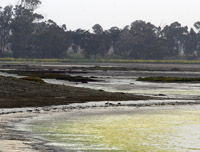 | |||||||||||
|
|
|
|
|
|
|
||||||
|
| |||||||||||
 May 4, 2009 Elkhorn Slough: Eroding ConfidenceResearchers debate howÔÇöor ifÔÇöto restore Elkhorn SloughÔÇÖs eroded bed
The wetland system of Elkhorn Slough has undergone dramatic change for decades, but now a group of local
scientists and conservationists is revving up a restoration project aimed at reversing many of these alterations and
letting one of CaliforniaÔÇÖs largest marshlands revert back to the ecosystem it once was. However, no one quite knows
what Elkhorn SloughÔÇÖs truly ÔÇťnaturalÔÇŁ state ever really was, and activists are at odds over precisely what
treatments the slough really needs, if any at all.
In 1947, the U.S. Army Corps of Engineers dredged out a large sandy berm to improve access to Moss Landing
Harbor. The bermÔÇöbasically a large sandbarÔÇöoccupied what is today the sloughÔÇÖs mouth, explains hydrologist Bryan
Largay, director of the Elkhorn Slough Tidal Wetland Project. Once it became exposed to the forces of the ocean, the
slough was cleaned out by wave action; the mud that layered the slough and provided habitat for vast beds of
shellfish was drawn out to sea, and the average slough depth increased from roughly 10 feet to as much as 25 feet
today. As water volume within the slough grew, the tidal currents became increasingly powerful, which quickened
erosion, which further greatened the water capacity. A positive feedback system has developed that some say
threatens to clear out the slough entirely.
Aaron Carlisle, a researcher with Hopkins Marine Station, worries that Elkhorn Slough could lose much of its
biodiversity if preventative and restorative action is not taken.
ÔÇťIf erosion isnÔÇÖt controlled, the slough is going to become just a coastal bay environment with nothing
estuarine about it,ÔÇŁ Carlisle says.
Carlisle conducted a tag-and-track study of Elkhorn Slough leopard sharks between 2003 and 2005, when he was a
graduate student at Moss Landing Marine Lab. He found that the three- to five-foot sharks strongly favor the lower
intertidal mud flats over any other part of the nearby marine environment.
ÔÇťBut eventually, all that habitat will disappear at the rate things are going,ÔÇŁ he warns.
The solution that he, Largay and others have discussed could be to block the erosive energy of the ocean with
a subsurface rock pileÔÇöat the mouth of either Elkhorn Slough or Parsons Slough, an important subregion within the
main bay. Additionally, the researchers have discussed rebuilding the mud bottom by dumping in fine-grained slurry
from local dredging operations or quarries.
But another shark researcher thinks those measures are unnecessary. Sean Van Sommeran of the Pelagic Shark
Research Foundation believes that leopard shark and bat ray numbers have increased in Elkhorn Slough partly due to
the availability of new habitat in Parsons Slough, where previously the mudflats lay high and dry most of the time
but subsided during the mid-1900s to below sea level. Van Sommeran has also observed an increase in marine mammals
within Elkhorn Slough.
ÔÇťTo me, increased numbers of sharks and rays is good news,ÔÇŁ he says. ÔÇťIncreased numbers of sea otters and
seals is good news.ÔÇŁ
Yet there is no question that the shallow muddy bottom of Elkhorn Slough that once supported abundant beds of clams
and other shellfish is long goneÔÇöor that bringing back this ecosystem would require restoring the mud bottom to the
slough and protecting it from the surging energy of the open ocean.
Largay says that restorative measures in Parsons Slough could serve as a pilot project and might be applied
later to the entire estuary if it indeed proves successful and beneficial to habitat and wildlife. The restoration
project is a public process, and the first meeting was held in December. The next public outreach event, a guided
group hike to Parsons Slough followed by a lecture, takes place June 17. Updates and information can be found at
www.elkhornslough.org. - Alastair Bland
Original URL (may no longer function): http://www.santacruz.com/News/2009/05/04/Elk_Slough:_Eroding_Confidence
Copyright © SantaCruz.com. All rights reserved.
|
 (SantaCruz.com) |
| |
[ home ] | [ contact us ] | [ support us ] | [ shop ] | ę Copyright 1990-2009 PSRF All rights reserved. |
Site Development by IT Director |